DHDD Newsletter – May 2022
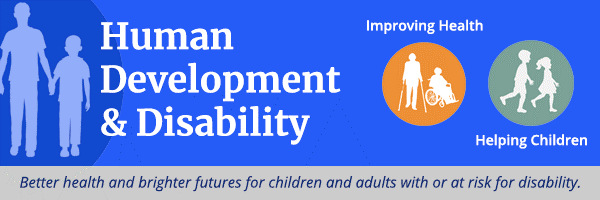
A Note from the Acting DHDD Director

Dear DHDD Partners,
I hope you are all doing well and staying healthy. May is mental health awareness month. Millions of Americans struggle with mental illness and mental health challenges. Additionally, COVID-19 has taken a drastic toll on mental health for many people, and has compounded the ongoing stress, strain, and pressures of daily living that many experience regularly.
As you know, there has been much in the mainstream news about mask mandates on public transportation. CDC has released updated mask guidance for public transportation. CDC continues to recommend that people wear masks in indoor public transportation settings at this time. You can read more here. Also, DHDD has provided support to the CDC COVID-19 response with the development of easy to read complementary pieces about the mask guidance. Please access those here and share broadly with your networks!
Finally, it is with mixed emotions that I share that Dr. Georgina Peacock has accepted a new leadership role here at the CDC by becoming the Director of the Immunization Services Division. Many of you know Georgina well and have worked closely with her for over a decade. While we will all miss her leadership and work here at NCBDDD, she will bring her collaborative leadership, passion, and knowledge to very important work at a critical time. Please join me in wishing her the best in her new role. I will continue to serve in the acting capacity until the permanent Division Director hire is made. Thank you for your continued support and partnership.
Best,
Blythe
In the Spotlight
May is Mental Health Awareness Month, and May 5th is Children’s Mental Health Awareness Day

This year’s theme: Together for Mental Health!
Supporting the mental health needs of children starts early in childhood and can have lifelong impacts on overall health and wellbeing. Parents, communities, schools, and healthcare providers all play a role in addressing the mental health needs of children, but often separately, with limited coordination and collaboration.
Supporting Children’s Mental Health: The Work of the Children’s Mental Health Champions The Children’s Mental Health Champions aim to address the needs of children with or at risk for mental disorders by building the foundation for a stronger, more inclusive mental health system for children. The Champions share common program goals, but each have their own approach that best fits the population they serve.
Learn what CDC’s Children’s Mental Health Champions are doing to create partnerships, identify concerns, intervene early, and promote children’s mental health by working with prevention programs in different settings.
26th Rosalynn Carter Georgia Mental Health Forum
The 26th Rosalynn Carter Georgia Mental Health Forum on May 18-19, 2022 featured Dr. Rochelle Walensky discussing the importance of mental health among children and the recent report, “Mental Health Surveillance Among Children – United States, 2013–2019.” The report is a follow-up to the first ever comprehensive and collaborative CMH report in 2013 and documents that poor mental health among children was a concern even before the pandemic.
Congratulations to DHDD’s Senior Medical Advisor!

Congratulations to Dr. Marshalyn Yeargin-Allsopp who was inducted into the 2022 Government Hall of Fame. This esteemed recognition “celebrates distinguished civil servants who have demonstrated sustained achievement and unparalleled dedication to public service throughout their careers”. This is an amazing achievement!
Disability and Health Data System: 2022 Update

NCBDDD’s Disability and Health Data System (DHDS) has been updated to include 2020 Behavioral Risk Factor Surveillance System (BRFSS) data. DHDS provides quick and easy access to data on demographics and health topics among adults with and without disabilities across the United States. Epidemiologists, researchers, and public health professionals can use these data to inform state and local health promotion activities to improve the health and well-being of people with disabilities.
DHDS includes BRFSS data analyzed from 2016, 2017, 2018, 2019, and 2020. Visit the Disability and Health Data System to learn about health differences between people with and without disabilities in your state and some territories.
In addition to the DHDS dashboard, CDC also has Disability & Health State Profiles that have been updated using 2020 BRFSS data. These fact sheets provide an overview of disability in each state, including the percentages and characteristics of adults with and without disabilities.
New Resources
May 6th is National Provider Day: CDC celebrates Early Care and Education Professionals!

Early care and education (ECE) providers are on the front lines of public health. ECE providers:
- Nurture, support, and monitor child development
- Support healthy growth and teaching healthy habits
- Protect children from diseases and injury, and
- Support parents
Learn what CDC is doing to support ECE providers in their important work.
New Spanish-language Caregiver Tipsheets Available!
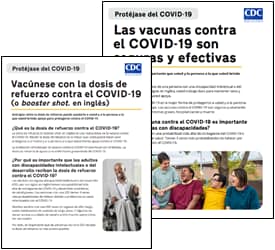
In collaboration with RTI International, DHDD has released two new tipsheets for spanish-speaking caregivers of people with disabilities. These tipsheets discuss the importance of getting a COVID-19 booster shot, vaccine safety and effectiveness, and why it’s important for the Hispanic community to get vaccinated against COVID-19. These tipsheets have been added to our resource list of accessible COVID-19 materials for Spanish-speaking people with disabilities. You can view them and more here. Please share with your networks!
New American Sign Language Video Available: Coping with Stress
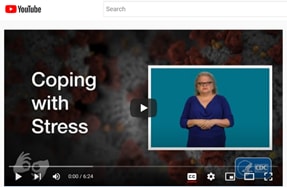
A new American Sign Language video is now available! Many people are dealing with stress from family life, work life, caregiving, and simply keeping up with day-to-day demands. Add to this the stressors of navigating life through a pandemic, and the stress can quickly become overwhelming.
This video provides healthy ways that people can cope with stress. You can view this video here. Please share broadly with your networks.
May is Arthritis Awareness Month!

Arthritis is a leading cause of disability in the US, affecting nearly 59 million adults. CDC works to improve the quality of life for adults who live with arthritis and other chronic conditions by promoting physical activity and self-management education interventions. Physical activity can help with pain, flexibility, and range of motion. Get active this summer by walking, gardening, or strength training. Learn more about interventions that can help with arthritis and other chronic disease symptoms. https://bit.ly/3Ol4O0t
New: Easy to Read Guidance on Masks and Traveling
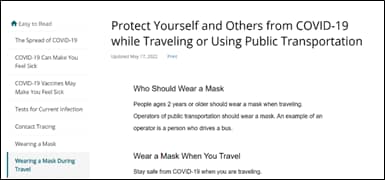
In case you missed it, CDC recently released updated guidance on how to protect yourself and others from COVID-19 when traveling and in transportation settings. It is recommended that people ages 2 years or older wear a mask when traveling and when in transportation settings. In accordance with the updated guidance, DHDD has added has created an easy to read version. You can view the easy to read here as well as other important COVID-19 related tips for staying protected. Please share with your networks!
Empowering Young People with Tourette Syndrome: Youth Leaders Helping Themselves and Others
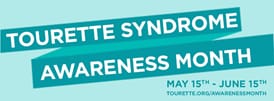
Having Tourette syndrome or another type of tic disorder can be hard on young people. Tics can be disruptive to other people, who may react poorly, particularly if they don’t understand what it is like to have tics or why a person can’t just stop doing them. Children with Tourette syndrome are more likely to be victims of bullying than their peers. The challenges with being accepted and the resulting stress puts long-term health and well-being of children with Tourette syndrome at risk. CDC partners with the Tourette Association of America (TAA) on the Tourette Outreach and Education Program to raise awareness and provide evidence-based education about tics and Tourette syndrome. Learn more about the Youth Ambassadors and Rising Leaders programs.
Notice of Publication: Notice of Funding Opportunity from CDC’s Child Development and Disability Branch
CDC’s Child Development and Disabilities Branch within the National Center on Birth Defects and Developmental Disabilities is announcing a Notice of Funding Opportunity (NOFO), published on May 19, 2022, on Grants.gov. A short description is provided below.
Funding Opportunity Number: CDC-RFA-DD23-2301
Title: Enhancing Public Health Surveillance of Autism Spectrum Disorder through the Autism and Developmental Disabilities Monitoring (ADDM) Network
Description: This NOFO will fund recipient organizations to participate in the Autism and Developmental Disabilities Monitoring (ADDM) Network, a population-based, multiple source records-based surveillance system for autism spectrum disorder (ASD). The goal of ADDM is to provide estimates of the prevalence and characteristics of children with ASD, monitor disparities by race/ethnicity and socioeconomic status, provide data to inform planning for resource and service needs, and foster activities to increase ASD awareness and reduce barriers to ASD identification. Funding will be offered through two components. Component A (required) will focus on conducting surveillance activities to estimate ASD prevalence among 4-year-old and 8-year-old children, while Component B (optional) will focus on conducting a surveillance snapshot among 16-year-old children with ASD. Recipients will be required to define a geographic surveillance area for activities, establish a memorandum of understanding (MOU) with multiple medical and education sources, obtain and review records, abstract data elements in accordance with established ADDM Network procedures, and provide clean record-level de-identified data that does not include the 18 HIPAA variables to CDC. ASD case definition will be determined by identifying the required documented ICD codes, eligibilities, or diagnoses in health and education records only. The data elements include information from comprehensive evaluations, ASD tests, IQ and adaptive tests, individual education plans, individualized family service plans, and other services. Recipients will also be required to conduct education and community outreach activities, which may include presentations, reports, and publications.
Component A activities include:
- Define a surveillance area.
- Establish agreements for access to BOTH health and education data sources (electronic and/or paper records.
- Use standardized ADDM Network methodology to conduct surveillance among 4-and 8-year-old children to estimate the prevalence of ASD.
- Train staff and conduct data quality assurance.
- Report clean, de-identified data with vital records/census linkages to CDC (as part of public health surveillance).
- Use ADDM Network data to conduct community education and outreach activities
- Conduct evaluation and performance measurement activities.
Component B activities include:
- Define a surveillance area (same area as Component A).
- Establish agreements for access to both health and education data sources (electronic and/or paper records)
- Used standardized ADDM Network methodology to conduct a surveillance snapshot.
- Train staff and conduct data quality assurance.
- Report clean, de-identified data with vital records/census linkages to CDC (as part of public health surveillance).
- Pilot data linkages to post-high school exit outcomes.
- Conduct evaluation and performance measurement activities.
Eligible Applicants: Open Competition
Estimated Timeline:
NOFO Publication Data: 05/19/2022
Letter of Intent Due Date: 07/29/2022
Application Due Date: 09/09/2022
Award Date: 12/02/2022
Project Period: 01/01/2023 – 12/31/2027
Estimated Funding:
Total Program Funding: $18,000,000
Approximate Total Fiscal Year Funding: $4,500,000
Award Ceiling:
- Component A: $450,000
- Component B: $150,000
Award Floor:
- Component A: $400,000
- Component B: $125,000
Approximate Number of Awards:
- Component A: up to 9 awards
- Component B: up to 3 awards
Please direct any questions regarding the application process to Anita Washington at addm@cdc.gov
Publications
Developmental Milestones Matter: Helping Caregivers and Providers Track Children’s Early Development

The Child’s Welfare League of America’s Children’s Voice has published an article on developmental milestones. Skills such as taking a first step, smiling for the first time, and waving “bye-bye” are called developmental milestones. Children reach milestones in how they play, learn, speak, act, and move. Tracking children’s milestones provides important information about their early development and can signal when a child may need extra support. Because early identification of possible developmental delays and receiving early support when needed can help children’s development, the CDC encourages all caregivers to track children’s milestones. CDC provides free, high-quality, family-friendly milestone checklists in a variety of formats to help caregivers regularly track milestones among children ages two months through five years. Read an excerpt of the article here.
Child mental and physical health, racial/ethnic discrimination, and other adverse childhood experiences

A new CDC study examined how child health is related to perceived racial/ethnic discrimination and other adverse childhood experiences (ACEs) among children ages 6-17 years using 2016-2019 data from the National Survey of Children’s Health. Results of the study suggested that both racial/ethnic discrimination and other ACEs negatively impact child health. Children who were discriminated against based on race or ethnicity had higher percentages of one or more physical health conditions (37.8% versus 27.1%), and one or more mental health conditions (28.9% versus 17.8%). Racial/ethnic discrimination was almost seven times as common among children with three other ACEs compared to those with no other ACEs. Public health efforts to prevent adversity in childhood, including racial or ethnic discrimination and other forms of racism, could result in improvements in child health.

